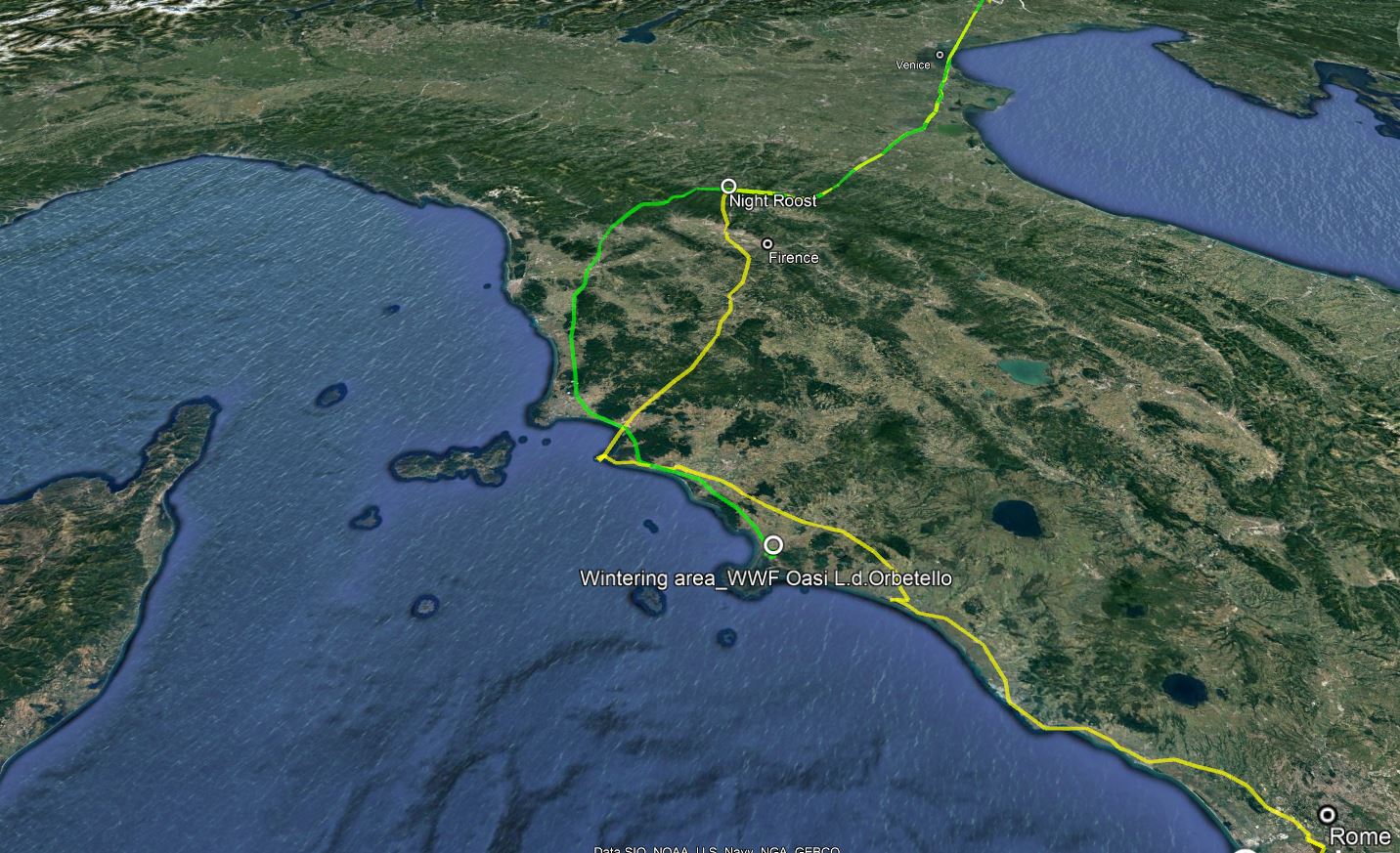News from the autumnal migration
Newsletter 05/11/2020
The migration of the Northern Bald Ibises is in full progress. For the last couple of days more and more ibises reach their wintering site in Tuscany while the rest of them is still on their autumnal journey.
A particularly exciting event was the flight of five juveniles from the colony Rosegg in Carinthia led by the migration experienced female Charlie. For the last weeks the group stayed in the Region of Friuli Venezia Giulia together with further conspecifics. Their flight can be reconstructed in detail, thanks to the fact that all our birds are equipped with GPS-trackers. On 20 October at 10:19 am the group left their common roosting site. After half an hour they reached Lido, near Venice, crossed the Po valley, at 3:20 pm they entered the Apennines and reached their new roosting site north of Florence at 900 metres above sea level at 5:34 pm. Thus, Charlie and the 5 juveniles flew for 7 hours and 15 minutes non-stop and covered 279 km with an average speed of 38 km/h!
On the next morning the birds started already at 6:54 am, an unusually early departure as the thermic conditions at that time are poor. Accordingly, they took a longer break already after 50 minutes and 21 km travel distance. At 9:23 am the group continued their flight and reached the wintering area without any further stops at 3:38 pm. During their 6 hours and 54 minutes flight on the second day, they covered 226 km with an average travel speed of 34 km/h!
Presumably the reason for the early departure was some kind of disturbance at the roosting site in the Apennines, which would explain why the female juvenile Bea lost touch with the group. She stayed at the night roost until 10:38 am and headed alone towards south-southwest, a direction typical for unexperienced juveniles. After 5 hours and 38 minutes and 154 km she reached the coast line at Punta Ala, hesitated briefly before crossing the sea where she stayed on a small island off the coast overnight. On the next day she returned to the mainland and followed the coast line south. Around noon Bea passed the wintering area of Orbetello only within few kilometres distance, where the rest of the group arrived just the day before. We assume that Bea didn’t meet any of her conspecifics, because she continued her flight without any hesitation and spent the night approximately 30 km south of Orbetello.
In the meantime, Bea has already reached Rome and she will probably continue her flight south. Her behaviour is typical for unexperienced, unaccompanied juveniles. Obviously, they follow an intrinsic direction heading south-southwest and adjust their path when they encounter the coast line, usually avoiding to cross the open sea. The future of Bea is unsure, if she survives until winter, our team will try to catch her and bring her safely to the wintering site, on condition that further restrictions to cope with the ongoing Covid19 pandemic in Italy won’t interfere with our plans.
The arrival of the first juvenile birds from Rosegg at the wintering site is regarded as a huge success for the project and a milestone for the establishment of the fourth breeding colony within the reintroduction project.
A major part of the breeding colony in Burghausen and Kuchl is still in the county of Salzburg and in the Inn valley. We expect them to leave towards south in the next couple of days. At the same time the GPS data of the still young breeding colony in Überlingen at Lake Constance provides us with reason to cheer. All 12 Northern Bald Ibises have left the breeding area, although 2 of them are still in Vorarlberg, Austria, the rest has already reached Italy. As a matter of fact, 6 ibises from Überlingen have actually reached their goal in Tuscany. Stay tuned to when the rest of the ibises will reach their wintering site by following their migration on the free App Animal Tracker.
Picture:
flight path according to the GPS data; at the night roost Bea (yellow) was separated from the rest of the group (green), she continued her journey in south-southwestern direction following the coast line. Her behaviour is typical for unaccompanied juveniles.





